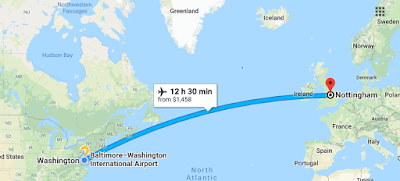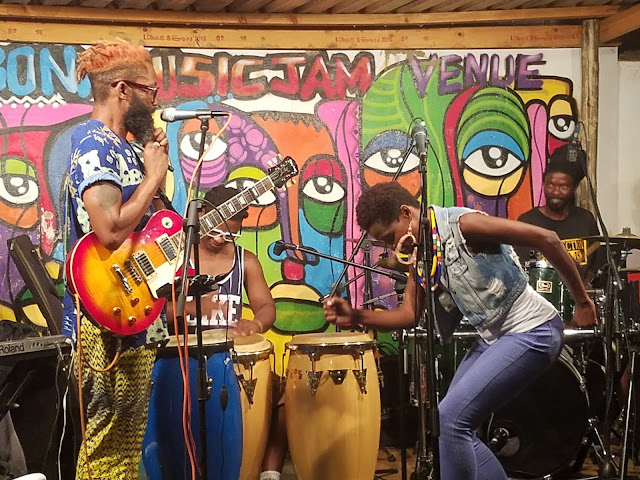London looks like a clean, sparkling New York City. It is amazing
– London has a Soho, and so does NYC. I arrived mid-afternoon, got settled in at the hotel, consulted with the hotel staff on things to do, put
on one of my batik dresses from Ghana and set out to see the city. My first
stop was the British Museum.
From its position across from stately townhouses,
to an expansive Hellenistic façade, it looks a lot the Metropolitan Museum of
Art (or I think the MET probably looks like it). When I walked inside, I saw that the
architecture of the building is beautiful. I headed straight for the Africa section.
Here is the deal with this institution. The British Museum houses magnificent
treasures from all over the world. Things that the British stole from other
nations. These are things that whole social studies curricula are based on. They hold the Rosetta Stone!...the Benin cast iron
plaques, ancient Egyptian tombs, everything. How did these people manage to get
their fingers on the whole world’s treasures?
 |
| Igbo Carved Wooden Door |
I enjoyed the Africa section. There was a beautifully carved wooden Igbo door and a Ndebele beaded apron. There were hand woven silk
textiles from Madagascar, and of course kente cloth from Ghana. For my Wakanda world folks, a Lesotho
blanket was a part of the textile exhibit (remember the men soldiers who had
the blanket shields made invincible with vibranium?) There was also an interesting
exhibit that links Nigerian Masquerade to carnival traditions in the African
diaspora.
 |
| Blanket from Lesotho |
 |
| Sculpture of Masquerade by Sakuri Douglass Camp (Nigeria) |
However, the jewel in the
crown, so to speak was, was the set of bronze plaques from 16th century Benin. I spent quite a few minutes studying the designs. They depict royal
kings, dual soldiers, women bearing baskets of food and Portuguese soldiers. A
thought came to mind. What if these were depictions of our ancestors or art works made by our ancestors? Definitively possible.
 |
| Benin Plaques |
After the Africa section, I rushed up to the Egyptian
exhibit. First of all. There is no question about it. Mystery solved. The
Egyptians were black.
 Next stop was Piccadilly Circus. I am sure you all know, but
this area is simply the center of the city, kind of like a clean version of
Times Square in NYC. I found a place that served the traditional British Afternoon Tea (They served it all day. I guess tourists like me want this. I know I was grateful since I did not make until around 6:00 pm, way after tea time. ) In honor of the visit I had earl grey. I have had high tea in Philadelphia, The Hay- Adams Hotel in Washington DC, Annapolis, Maryland, The Four Seasons in New York City, Kathleen's Tea Room in Peekskill, New York, Ottawa, Canada and now London, England. There were very generous tea sandwiches, including a very delicious salmon and soft cheese (the British word for cream cheese). As a high tea connoisseur, I have to say that I think the American teas skimp on the sandwiches. I also think this was the first time I have had genuine Devonshire clotted cream. It is not sweet at all but very rich. Given the American taste for sugar (I have heard foreign visitors remark on how very sweet everything is in the US) the American teas tend to add a whipped cream kind of element to their versions of the clotted cream. Anyway, each country and culture shares cuisine that is enjoyed by all. Senegal gives us thiebu djen. Nigeria, egusi soup. Botswana, seswa and oxtails. Ghana, well, all kinds of things. India…kormas, mango lassi (and much more), Japan, sushi. For the English, in my opinion, it is the Afternoon Tea.
Next stop was Piccadilly Circus. I am sure you all know, but
this area is simply the center of the city, kind of like a clean version of
Times Square in NYC. I found a place that served the traditional British Afternoon Tea (They served it all day. I guess tourists like me want this. I know I was grateful since I did not make until around 6:00 pm, way after tea time. ) In honor of the visit I had earl grey. I have had high tea in Philadelphia, The Hay- Adams Hotel in Washington DC, Annapolis, Maryland, The Four Seasons in New York City, Kathleen's Tea Room in Peekskill, New York, Ottawa, Canada and now London, England. There were very generous tea sandwiches, including a very delicious salmon and soft cheese (the British word for cream cheese). As a high tea connoisseur, I have to say that I think the American teas skimp on the sandwiches. I also think this was the first time I have had genuine Devonshire clotted cream. It is not sweet at all but very rich. Given the American taste for sugar (I have heard foreign visitors remark on how very sweet everything is in the US) the American teas tend to add a whipped cream kind of element to their versions of the clotted cream. Anyway, each country and culture shares cuisine that is enjoyed by all. Senegal gives us thiebu djen. Nigeria, egusi soup. Botswana, seswa and oxtails. Ghana, well, all kinds of things. India…kormas, mango lassi (and much more), Japan, sushi. For the English, in my opinion, it is the Afternoon Tea.
After tea I decided to explore Piccadilly Circus on foot. By
the way, this was a rainy day. Once again, my shoes were soaked, but I did not
care. I had borrowed an umbrella from the hotel and was determined to see
London. I bought a souvenir tea from a kind of tea emporium (photo above). They sell them
loose. Somehow, this visit helped me understand that tea blending is an art. I
bought a rose tea, which the kindly gentlemen sales clerk kept telling me was from
a French province, so it was “very good
quality.” I just smiled politely. After the tea emporium, I had a 'romp' around London.
Piccadilly Circus is the area where all of the Broadway shows are playing. Identical to
Times Square in NYC. I meandered around until ran into London’s China town.
What did I find? An exact replica of the dome in DC’s china town. There were
many dim sum restaurants and Chinese grocery stores. A group of hare krishnas were dancing and singing in the middle of the street. I guess it was
fascinating (and sad) to watch them, because they were all English. They drew a crowd of amused spectators. I guess they found the sight entertaining - English men
and women dressed in traditional Indian clothes, with their faces painted and
wearing marigold garlands. I have to confess, family. I found this to be very
amusing as well.
I spent the time strolling and taking photos with a big,
enthusiastic grin on my face. I did not care that I probably stood out as a
tourist. I was a tourist and was enjoying myself. Just behind China town is the original
Soho. For those who know New York, London’s Soho looks very much like Greenwich
Village of New York City. More strolling and more photos. It was getting dark.
Without warning, I walked passed Ronnie Scotts. Wow! Ronnie Scotts is a famous jazz club in
London. Ella Fitzgerald did a show there that is featured at the end of her documentary Something to Live For. I
had already checked out the possibility of a visit online before I left the hotel, but tickets were sold
out. Joe Lovano and Dave Douglass were headlining. I thought I would try
anyway. I told the men at the door that I was from the US, visiting just for the day and just wanted to
hear some music. After a few minutes of waiting, and the equivalent of $54 dollars later, I was ushered to a premier seat, right in the front. I guess the Lord had planned this day for me, because it could not have had a more perfect end!
There I was in Ronnie Scott’s, a place I never thought I would be able to visit. I ordered a rose champagne to toast the occasion. The music was very nice. I learned that even jazz musicians at the career level of Joe Lovano and Dave Douglass still have to hustle. They were standing at the front selling their CDs as I left. Dave seemed surprised when I congratulated him on the show in my American accent. When I went out to the street again, the mood had shifted. This was late night and people were hanging out and drinking. I decided to grab a sandwich and head back to the hotel. They had a hamhock sandwich that I decided to try. (Hamhocks!)
I also got ‘mature cheddar crisps’ (cheesy potato chips). I think the 'mature' description is what we call 'sharp' cheddar. Anyway, I knew it was time to go and got a strong feeling that I should get straight into the cab. But I still wanted to see a little of late night Soho. At the sandwich/coffee place, my American accent attracted a little attention. Men sitting on stools turned their faces towards me and smiled as I spoke to the cashier. This turned out to be too much attention. As I went into a small ‘corner store’ further down the street, I realized that a man from the coffee place had been following me. Yikes! When I came out he was waiting for me! It was at that moment that I became very grateful for the dress I had chosen to wear. It was one of my Ghanaian batik dresses, with a generous hemline, well below the knee. I had on a sweater also, so no bare arms. I looked nice and well - mannered (so to speak). When I saw this strange man waiting outside of the store, I smiled politely, gestured a 'no' with my hands, crossed the street to get away from him and got directly into a taxi. It was time to go. Back at the hotel, I enjoyed my sandwich, watched a movie and went to sleep.
The next morning a taxi took me to Victoria Station to get the
express train to Gatwick Airport. I asked him to take the scenic route so I could
see London Bridge. It’s just a bridge ya’ll. It was built in 1850. How did this bridge come to loom large in
the minds of Americans as the reference point for the city? London bridge is falling down, falling down,
falling down, falling down. London bridge is falling down, my fair lady. (As
I sang it during my selfie photo shoot on the bridge, I noticed that the song
is the same tune as Mary Had a Little Lamb. I think I will write more about the
social conditioning function of nursery rhymes later.) At any rate, I also saw Big Ben
(it is surrounded with scaffolding for repairs I guess) and Westminster Abbey.
And that was my stay in London. I had a fabulous time.












































